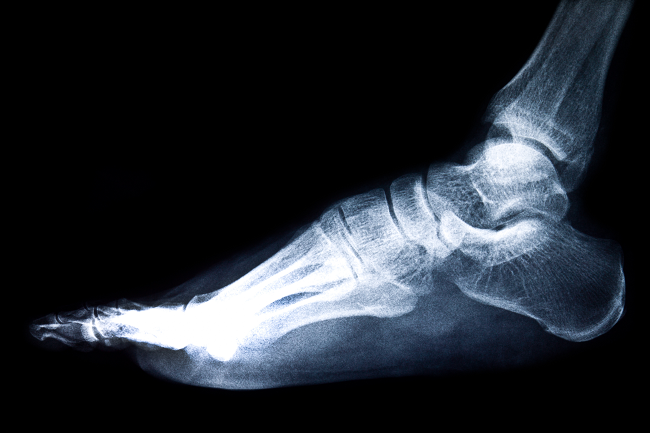Are your daily activities limited due to ankle pain? Ankle arthritis — most often occurring from osteoarthritis, rheumatoid arthritis, or post-traumatic arthritis — is one of the major causes of ankle pain.
Many individuals now have advanced surgical options to eliminate or substantially reduce ankle pain. If you have completed at least six months of conservative therapy with modalities, such as bracing, anti-inflammatory medications, and a cane or crutches — and had little success — you may be a good candidate for an ankle replacement.
When the ankle is replaced, the worn-out joint surface is removed and resurfaced with a cobalt-chrome metal alloy and a polyethylene plastic spacer. These components replace the damaged cartilage surfaces and are designed to decrease arthritic pain while maintaining joint motion. Maintaining ankle motion likely reduces the possibility of developing further arthritis in the foot that may progress with other procedures that sacrifice motion. Preservation of motion may also help maintain a normal walking pattern, especially on uneven surfaces.
Ankle replacement may not be the right choice for individuals with previous ankle infections, diabetes, neuropathy, or those who are severely obese. Moreover, young adults who engage in high-impact activities, such as running or jumping, may want to consider alternative treatment options.
Preoperative evaluation
During your initial office visit, your surgeon will review your history and previous ankle images, such as radiographs, MRIs, and CT scans. Even if you have existing radiographs, your visit will likely include new standing, weight-bearing radiographs of your foot and ankle. We will answer any questions regarding the ankle replacement surgery and also discuss treatment alternatives.
The surgical procedure
Ankle replacement is performed in an operating room suite with an anesthesiology team and an orthopedic surgery team. Most of the time, this includes general anesthesia — and most patients elect to have a popliteal nerve block to help with regional pain control after the procedure. The nerve block is left in place for up to three days and often substantially decreases postoperative pain. The surgical procedure usually takes about two hours. Depending upon your age, medical conditions, and how far you’ve traveled, you will likely stay in the hospital overnight.
After surgery
During recovery, highly skilled nurses and associates from our orthopedic department will see you each day. A physical therapist may assist you in learning to walk safely with crutches or a walker without putting too much pressure on your new ankle.
Most of your early recovery period will be spent resting and elevating your leg to decrease swelling. At the time of discharge, we will protect your ankle with a supportive splint. A couple weeks later, we will see you in the office to check your incision and place your ankle in a fiberglass nonweight-bearing cast. At your three-week office visit, sutures are removed, and you will receive a new walking cast. Typically, you can start ankle motion exercises at three to six weeks — when you are transitioned into a removable boot. Most patients are back into a regular shoe around three months after surgery.
In the United States, current generation ankle replacement procedures began with an FDA approval process starting in 1999. In some studies, success rates of ankle replacement parameters have been equivalent to or better than ankle fusions. A 2011 study, for example, reported a 90% implant success rate at follow-up visits nearly 10 years after surgery. The advantages of replacement over fusion include the ability to maintain motion, protection of the surrounding joints from developing arthritis, and possibly quicker weight-bearing after surgery.
Jesse F. Doty, M.D., is a fellowship-trained foot and ankle orthopedic surgeon accepting new patients with foot and ankle problems at UT Erlanger Foot and Ankle Institute. To make an appointment, call 423-778-2564.







